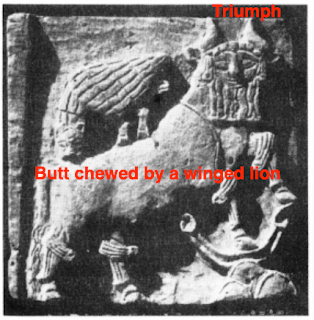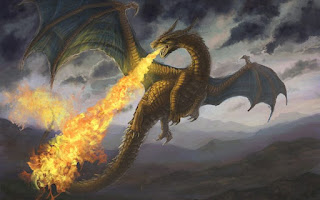Sumerian lapis lazuli amulet of a bull, early dynastic iii period, 2650-2350 b.c. the reclining bull with bearded human head, curved horns...Sold by Christies...
Who's this guy?
Well, Utu / Shamash, the sun god...
Every spring, the sun god Utu / Shamash climbs the holy mountain (Abzu) to free Enki / Ea, the god of sweet water from his icy prison...I talked about this in my post "Shamash young and old"...
This freeing of Enki is an euphemism for snowmelt, in the mountains north and East of Mesopotamia, which are the source of Tigris and Euphrates. Snowmelt contributes more than 70% to the annual water flow of these great rivers. And this water flow peaks at the beginning of summer, Apr/May in Taurus...
Which is why Shamash is depicted as a golden bull with long flowing "lapis lazuli" (water) beard...
"Enki placed in charge of the whole of heaven and earth the hero, the youth Utu (Shamash), the bull standing triumphantly, audaciously, majestically...the great herald in the east of holy An...with a lapis-lazuli beard, rising from the horizon..."
Do you want to know why there is a winged lion chewing on the butt of Utu / Shamash? I talked about this in my post "Butt chewing"...
Anyway, we can see that in Mesopotamia bull with a human face and beard was a solar symbol...
What is amazing is that few thousand years earlier in the Balkans we find this guy...
Oh hello there, gorgeous 🙂 A Neolithic bull with human face and beard from Bulgaria...Karanovo Culture, 5th mill. BC...
This version of the bull man seem to have been popular across Neolithic Central Europe...
This 7,000-year-old ceramic horned face pot shard, was discovered in Poland. The object was found during the excavation of the Early Neolithic site in Biskupice, southeast of Krakow...
Now we don't know if this bull man was also a solar bull, like the Mesopotamian one...
But we know that until recently bull was seen as a solar animal in the Balkans...
In Serbia and Bulgaria there are legends about monstrous bulls who lived in lakes and to whom local people sacrificed young girls...Anyone reminded of any famous legends?
And around one lake in Serbia, there are two versions of the same legend, one talking about a bull living in the lake, and one talking about a dragon living the lake...I talked about this in my post "Water bull"...
Sooo???
Now we know that dragon of a fire breathing variety, is a symbol of the summer, and particularly the end of summer, Jul/Aug, the hottest and (usually) driest part of the year, the time of droughts...Dragon was used as symbol for dry hot part of the year in Eurasia since Neolithic until today...I talked about this in many of my posts, for instance "Dragon who stole rain", "Seven headed dragon", "Winged superhuman hero", "Is that you Gilgamesh"...












No comments:
Post a Comment